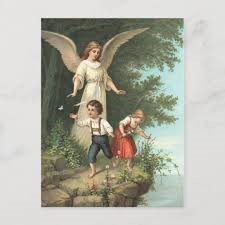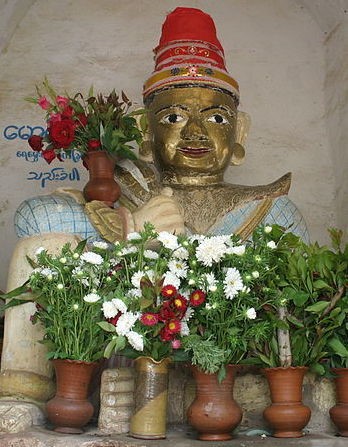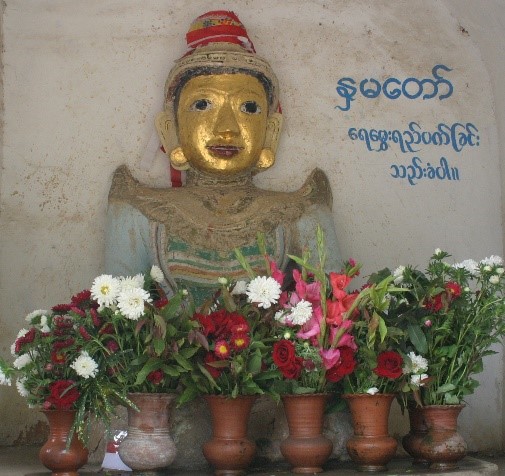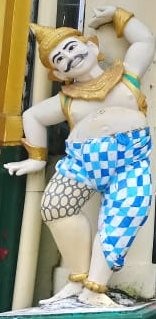Some remarks on Burma's animist nats
Belief in spirits (animism) can be found to a greater or lesser extent among all the peoples of Myanmar, probably most strongly among the tribes in the outlying areas. The Bamar people commonly summarize spirits under the term nat (pronounced na’). They are also known by that name to foreigners. The word is commonly traced back to the Sanskrit word natha, roughly meaning lord or master (see, e.g., temples of Pashupatinat, Swayambunath, and Bodnath in Kathmandu). My teacher Uta Gaertner (quote) points out … that this could be an accidental consonance with a Tibeto-Burman word, since the belief is undoubtedly older than the contact with India. An indication could be that in the Myanmar word, in contrast to other customs in loan words, the long ‘A’ is not marked. Not even in the inscriptions of the Bagan period. But there is no evidence for it. (end of quote)
The term nat is not used uniformly and by no means only includes the area of animism: Hindu gods like Mahapeinne, Mara (the ‘devil’)and sometimes even the Buddha (wi.thou’di.na’ = the pure Nat) himself (!) are so designated. Likewise the king (lo:ka. thamu.di. na’). Significantly, coconuts and bananas are offered in front of the Buddha image in the ‘Wish Fulfillment Pavilion’ on the Shwedagon (south-west corner) – actually typical offerings for spirits! Notions of spirits and souls are widespread in Myanmar, although Buddhism rejects them as well as the notion of an almighty God in the Christian or Islamic sense. But who would deny that the Burmese accept the existence of a soul? There are even very precise ideas about it: It is thought of in the form of a butterfly (lei’pja). The idea of a soul butterfly also exists in Europe, along with numerous other soul animals (such as cats or bats). After the death of a person, the lei’pja leaves the body and has to be appeased
through various ceremonies. Failing this, the soul cannot find peace and may be forced to roam around as tahsei, who don’t even shy away from devouring people. Similarly unpleasant manifestations are thajei:, ou’da zaun. or the ogres ba lu: or ba lu: ma. and whatever else they are called. Ba lu:-Statues even adorn many temples and stupas (including Shwedagon): they are supposed to protect the place by warding off evil. As is well known, the Burmese kings executed people at the city gates or on the city walls – their spirits were supposed to protect the city (see e. g. the story of ‘Byatwi and Byatta’ or the founding of Mandalay). In contrast to nature spirits, which may be benevolent as well as malevolent, the ones mentioned above are definitely evil! It is therefore recommended to give them a wide berth.
In the early 1960s, the American anthropologist Melford E. SPIRO researched the belief in spirits in a village in Upper Burma, which he called Yei Gyi. The resulting book ‘Burmese Supernaturalism’ is widely regarded as a standard work. However, it must be taken into account that his study is almost sixty years old and modern research results naturally could not be incorporated into it. Furthermore, the village had only 146 inhabitants and therefore cannot be considered to be representative of all of Upper Burma – let alone the whole country. After all, he seems to be the first western researcher to recognize the difference between inside and outside nats. He created a classification of the spirits worshipped in Yei Gyi, but excluded the gods (deva) who, for many Burmese, also belong to this group. In Mt. Popa’s spirit shrine and elsewhere you can find their statues next to those of ‘indigenous’ Burmese Nats: I remember having seen statues of Sarasvati, Durga and Ganesha, whom the Burmese call Maha Peinne …
Despite the concerns mentioned above, I will adopt his system in the following. He distinguishes five categories:
1. personal nats (kou saun.-na)
2. house nats (ein saun.-na‘)
3. village nats (jwa saun.-na’)
4. family nats (mi.hsain hpa. hsain na’)
5. nature nats

Kou saun.-na’ are guardian spirits for individuals. In them, some elements of the Burmese idea of the soul (lei’pja) are mixed with the idea of a self, a materialized consciousness, so to speak. As to their number, there are different opinions: some say that there is only one, others talk of two, still others of one hundred and eight all the way to a thousand. Many Burmese distinguish twelve kou saun.-na’: six good and six bad, who are constantly fighting each other. The person behaves depending on who has the upper hand. So you could – in a way! – identify them with guardian angels (especially for children)as they are known in Christianity (see picture).

Ein saun. na’s guard the house. Usually, Min Mahagiri and his sister Golden Face are considered to be the guardians of the house. Moreover, Min Mahagiri is identified as the ‘leader’ of the terrestrial nats when Thagyarmin, ‘the king of gods’, is not present. These two died by fire and that is why they value the milk of the coconut, which is used in Myanmar to cool burns. In many houses Min Mahagiri’s shrine with a coconut can be found on the southeast side. The coconut has to be replaced about every four months. The hanging of a new coconut is often associated with the donation of other offerings. But of course never candles, as this would remind him of his suffering at the stake and evoke his revenge. Like many of their ‘colleagues’, these two need to be treated with caution! They are particularly irritable at deaths and births – in which case the coconut must be cut down in order to ward off misfortune! If you hurt their feelings, they can conjure up disease, poverty and strife among the residents. On the other hand, if you follow all the rules and keep them happy, they will avert damage to the house e.g. by chasing away burglars!


Jwa saun.-na’s are responsible for the protection of villages and cities (see Bagan’s Tharabar gate). These nats may vary from region to region. The most famous of them is certainly Myinbyushin (Lord of the White Horse), who is especially revered in Upper Burma and who is counted among the thirty-seven nats on some lists. To the confusion of many foreigners, he is often also called Bobogyi and can therefore easily be confused with the nature spirit of the same name (see below). Myinbyushin and his colleagues protect the village against external enemies, but they are powerless against internal adversaries! The shrine of jwa saun.-na’ is usually placed at the entrance to the village, either on a tree or on a pillar. It often contains offerings such as water, some food, leaves or flowers and white horse puppets.
Mi hsain hpa. hsain nats are family nats ( (mi. hsain means ‘mother’s side’, hpa. hsain ‘father’s side’). They refer not only to the area one lives in, but also to that of origin – they are, so to speak, hereditary!
When one moves to another area (e.g. from the country to the big city), he takes with him the family nats of the area of origin. Of course, the newcomer must also worship the nats of his new home.
Finally, the nature spirits are the spirits of sky, earth, rain, trees, etc. They are probably the most ancient of the nats, but have lost their former importance. The only one who still plays an important role today is the tree spirit Yokhasoe (i.e. tree guardian, see picture), whose shrines can be found on many banyan trees. His statue is also often seen in religious places (e.g. Shwedagon Stupa): there he is depicted as a small man with a longyi rolled up and a big belly. He is also symbolizing fertility and some women may pay respect to him in order to get pregnant. He belongs to the same category as the Nat Moe Kaung Kyaw Swa who can summon rain. I’ve occasionally seen tug-of-war competitions related to his cult. The belief in the guardian spirit Bo Bo Gyi is also very old. In a way he represents a transitional form from the natural nats to the famous thirty-seven nats. We can find him on the platform of the Shwedagon as well as on Shwenyaungbin near Htaukkyant and in many other places. We might say that if there is no special protective nat somewhere, Bo Bo Gyi takes his place.
